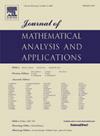Adjointable maps between linear orthosets
IF 1.2
3区 数学
Q1 MATHEMATICS
Journal of Mathematical Analysis and Applications
Pub Date : 2025-03-17
DOI:10.1016/j.jmaa.2025.129494
引用次数: 0
Abstract
Given an (anisotropic) Hermitian space H, the collection of at most one-dimensional subspaces of H, equipped with the orthogonal relation ⊥ and the zero linear subspace {0}, is a linear orthoset and up to orthoisomorphism any linear orthoset of rank ⩾4 arises in this way. We investigate in this paper the correspondence of structure-preserving maps between Hermitian spaces on the one hand and between the associated linear orthosets on the other hand. Our particular focus is on adjointable maps.
We show that, under a mild assumption, adjointable maps between linear orthosets are induced by quasilinear maps between Hermitian spaces and if the latter are linear, they are adjointable as well. Specialised versions of this correlation lead to Wigner-type theorems; we see, for instance, that orthoisomorphisms between the orthosets associated with at least 3-dimensional Hermitian spaces are induced by quasiunitary maps.
In addition, we point out that orthomodular spaces of dimension ⩾4 can be characterised as irreducible Fréchet orthosets such that the inclusion map of any subspace is adjointable. Together with a transitivity condition, we may in this way describe the infinite-dimensional classical Hilbert spaces.
求助全文
约1分钟内获得全文
求助全文
来源期刊
CiteScore
2.50
自引率
7.70%
发文量
790
审稿时长
6 months
期刊介绍:
The Journal of Mathematical Analysis and Applications presents papers that treat mathematical analysis and its numerous applications. The journal emphasizes articles devoted to the mathematical treatment of questions arising in physics, chemistry, biology, and engineering, particularly those that stress analytical aspects and novel problems and their solutions.
Papers are sought which employ one or more of the following areas of classical analysis:
• Analytic number theory
• Functional analysis and operator theory
• Real and harmonic analysis
• Complex analysis
• Numerical analysis
• Applied mathematics
• Partial differential equations
• Dynamical systems
• Control and Optimization
• Probability
• Mathematical biology
• Combinatorics
• Mathematical physics.

 求助内容:
求助内容: 应助结果提醒方式:
应助结果提醒方式:


